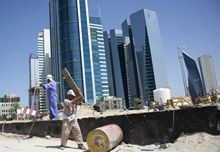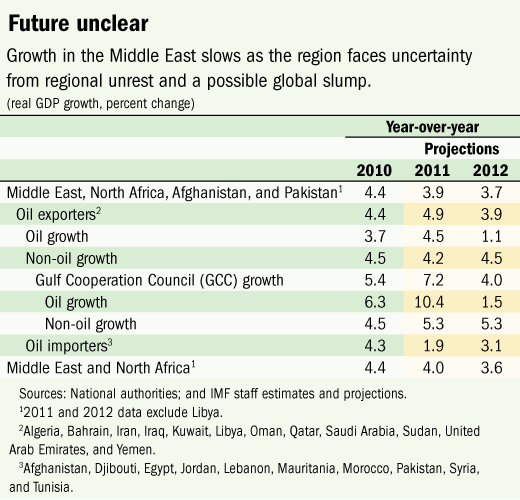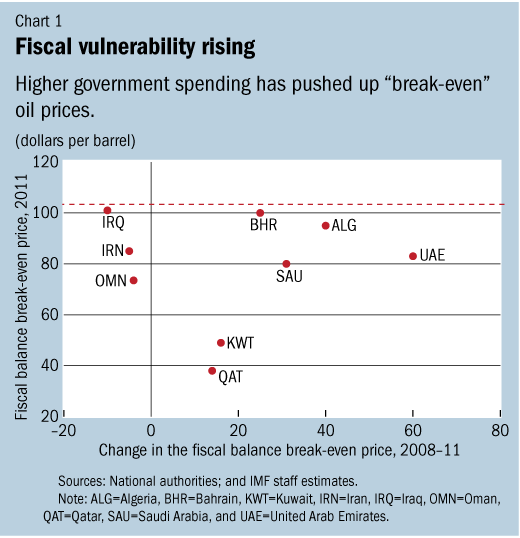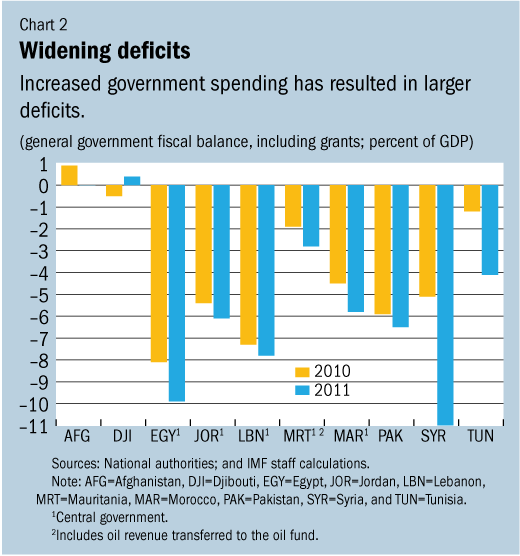
Typical street scene in Santa Ana, El Salvador. (Photo: iStock)
IMF Survey: Mideast Outlook Varies Markedly Across Region
October 26, 2011
- Region faces uncertainty from a possible global slump and regional unrest
- Oil-exporting economies buoyed by higher oil prices
- Oil importers face slow economic recovery
Countries across the Middle East and North Africa face a diverging economic outlook, with oil exporters experiencing a pickup in growth in 2011 on the back of higher oil prices and oil importers seeing a dramatic downturn as the region faces heightened regional and global uncertainty, the IMF says in its latest assessment.

Construction site in Kuwait City: Increased oil revenues have given the region’s oil exporters more scope for government spending (photo: STR/RTR/Newscom)
REGIONAL ECONOMIC OUTLOOK
The IMF’s Regional Economic Outlook for the Middle East and Central Asia, released October 26, projects growth in the Middle East and North Africa region at 3.9 percent in 2011, down from 4.4 percent in 2010.
The region’s oil-exporting countries (excluding Libya)—Algeria, Bahrain, Iran, Iraq, Kuwait, Oman, Qatar, Saudi Arabia, Sudan, the United Arab Emirates, and Yemen—are forecast to expand by 4.9 percent in 2011, thanks to higher oil prices and oil production, before moderating in 2012.
But growth among the region’s oil importers—Afghanistan, Djibouti, Egypt, Jordan, Lebanon, Mauritania, Morocco, Pakistan, Syria, and Tunisia—will register just under 2 percent in 2011 (see table).
“Since the beginning of this year, the region has witnessed unparalleled uncertainty and economic pressures,” Masood Ahmed, Director of the IMF’s Middle East and Central Asia Department, told a press conference in Dubai. The recent worsening of the global economy, he added, would likely add to these pressures.
“But we should not lose sight that the ongoing historical transformation holds the promise of improved living standards and a more prosperous future for the people in the region,” he stressed.

Oil exporters benefit from higher oil prices
Economic activity in the region’s oil-exporting countries has clearly improved, bolstered by continued high energy prices. This expansion is driven by the high level of activity in the countries of the Gulf Cooperation Council (GCC), where growth is projected at 7 percent in 2011. Several countries—Saudi Arabia in particular—have stepped up oil production temporarily in response to higher oil prices and shortfalls in production from Libya.
“The decision to increase oil production in the wake of disruptions in Libya was an essential contribution toward global energy market stability and enhanced activity,” Ahmed noted.
Increased oil revenues have created additional room for government spending in the GCC. Several countries announced spending programs early in the year covering a wide spectrum of measures, such as subsidies, wages, and capital expenditure. At current projected oil prices and levels of production, revenue gains will more than offset the high levels of public spending. In 2011, the oil exporters’ combined external current account balance is expected to increase from $202 billion to $334 billion (excluding Libya), and from $163 billion to $279 billion for the GCC.
Fiscal vulnerability has also increased, however, as break-even oil prices—the prices at which the fiscal balance is zero given the level of expenditure and non-oil revenues—have risen steadily and are now approaching observed oil prices (see Chart 1).

As economic activity picks up, financial sectors are gradually recovering. GCC banks in particular, which showed considerable resilience during the global crisis, are now registering capital adequacy ratios of between 15 percent and close to 20 percent, with nonperforming loans of less than 10 percent. But private-sector credit growth remains cautious.
In 2012, growth is expected moderate to about 4 percent. Several factors could result in a less positive growth scenario for region’s oil exporters. The most immediate risk is a sharp slowdown in Europe and the United States. Global oil demand would contract substantially, possibly leading to a sustained drop in oil prices.
Oil importers strive to meet social needs, restore confidence
As for the region’s oil-importing countries, the political and economic transformations occurring in several of them are expected to extend well into 2012. Together with a worsening economic outlook globally, and in the European Union—where growth is forecast to slow from 1.7 percent this year to 1.4 percent in 2012—the region is seeing a sharp drop in investment and tourism activity.
As a result, growth is down sharply this year, and the recovery in 2012 is expected to be weaker than earlier anticipated, with growth projected at just over 3 percent.
In response to growing social unrest, the economic downturn, and higher commodity prices, governments in the region have significantly expanded subsidies and transfers The cost of this social spending is high, exceeding 10 percent of GDP in Egypt and more than 5 percent of GDP in most other countries. As a result, oil importers’ fiscal deficits are widening by an average of about 1.5 percent of GDP to –7.6 percent of GDP in 2011 (see Chart 2).

In the near term, such spending measures are appropriate to lessen the impact of the downturn. But from an efficiency and equity standpoint, it is better for governments to gradually replace universal subsidies with targeted social safety nets, the IMF report states. Resources can then be used for critical investments in infrastructure and education and for supporting much-needed reforms.
Meeting the rising demands of the population will not be easy, the report notes—particularly as most countries have already used their fiscal and international reserve buffers to respond to deteriorating economic conditions in the wake of the Arab Spring, and have much less room left to respond to future shocks.
Given the increased risk aversion of international financial markets, the cost and availability of private financing will be constrained in the near term, but governments have the option of turning to official sources for external and fiscal financing, says the IMF assessment. Regional and international partners can help formulate and implement a reform agenda through technical assistance, debt relief, concessional financing, and greater market access.
Conflict across the region—particularly in Libya, Syria, and Yemen—has taken a massive human toll in addition to its enormous economic costs. The immediate priority for these countries is to avoid further humanitarian crisis and, once the conflict is over, to pursue an agenda of reconstruction and reform.


